Abstract
Polymorphisms in many xenobiotic metabolizing enzymes occur leading to variation in the level of enzyme expression in vivo. Enzymes showing such polymorphisms include the cytochrome P450 enzymes CYP1A1, CYP1A2, CYP2A6, CYP2D6, and CYP2E1 and the phase two metabolism enzymes glutathione S-transferase MI (GSTMI) and arylamine N-acetyltransferase 2 (NAT2). In the past, these polymorphisms have been studied by phenotyping using in vivo administration of probe drugs. However, the mutations which give rise to several of these polymorphisms have now been identified and genotyping assays for polymorphisms in CYP1A1, CYP2A6, CYP2D6, CYP2E1, GSTMI, and NAT2 have been developed. Specific phenotypes for several of the polymorphic enzymes have been associated with increased susceptibility to malignancy, particularly lung and bladder cancer, and Parkinson's disease. These associations are likely to be due to altered activation or detoxication of chemicals initiating these diseases, including components of tobacco smoke and neurotoxins. The substrate specificity and tissue distribution of polymorphic enzymes implicated in disease causation discussed with particular reference to previously described disease-phenotype associations.
Full text
PDF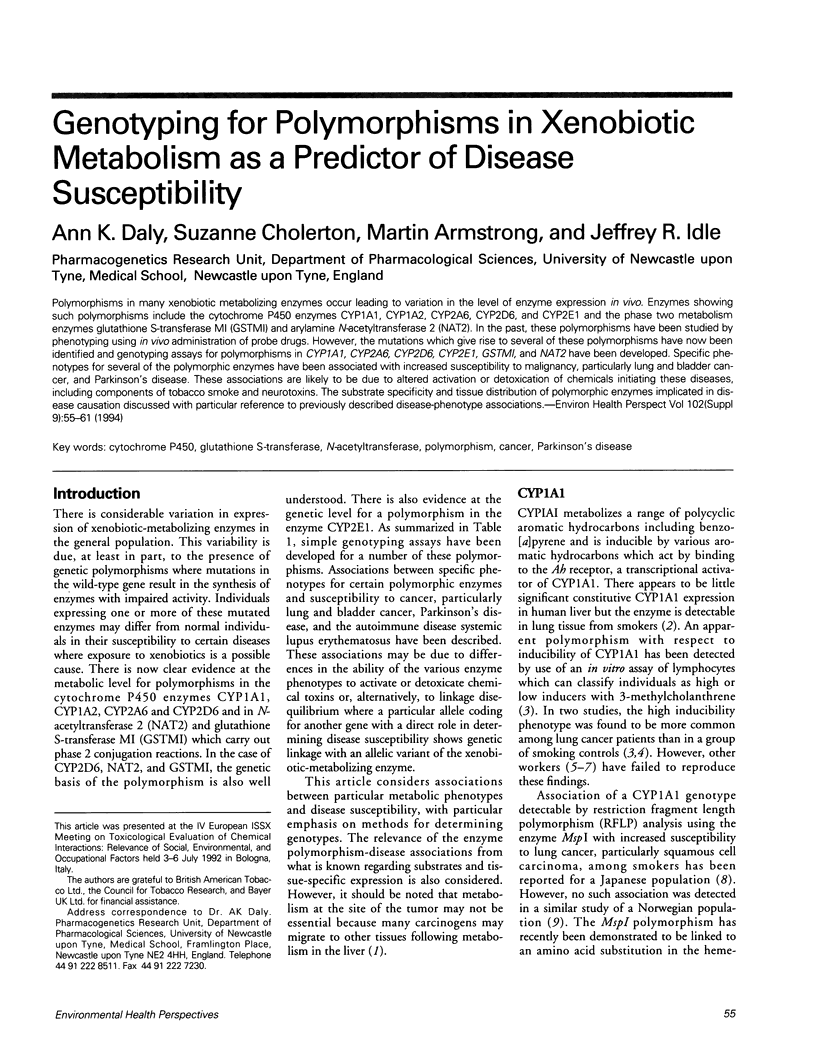
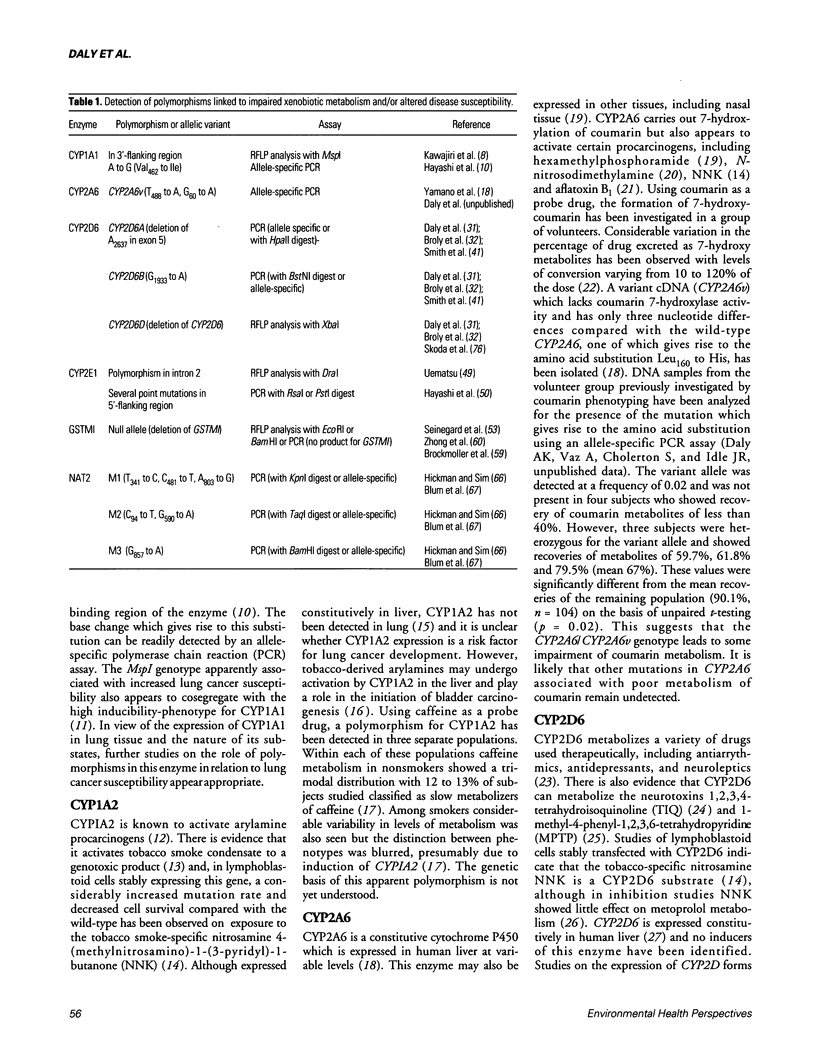
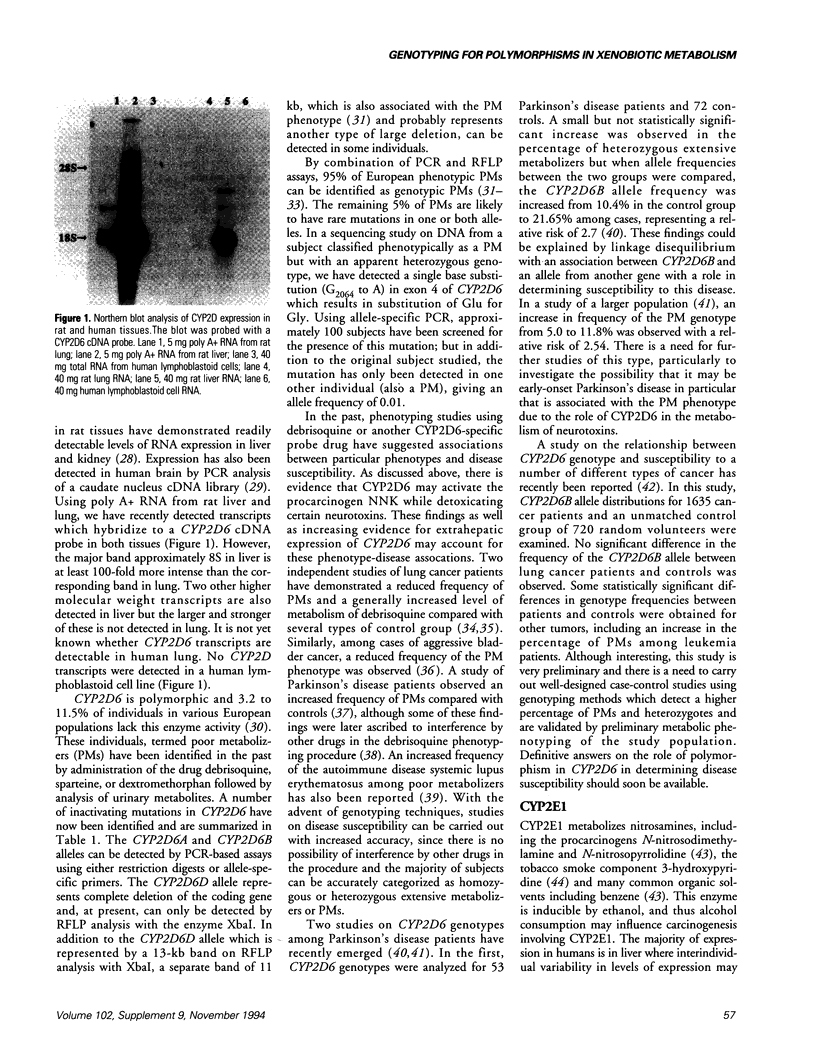
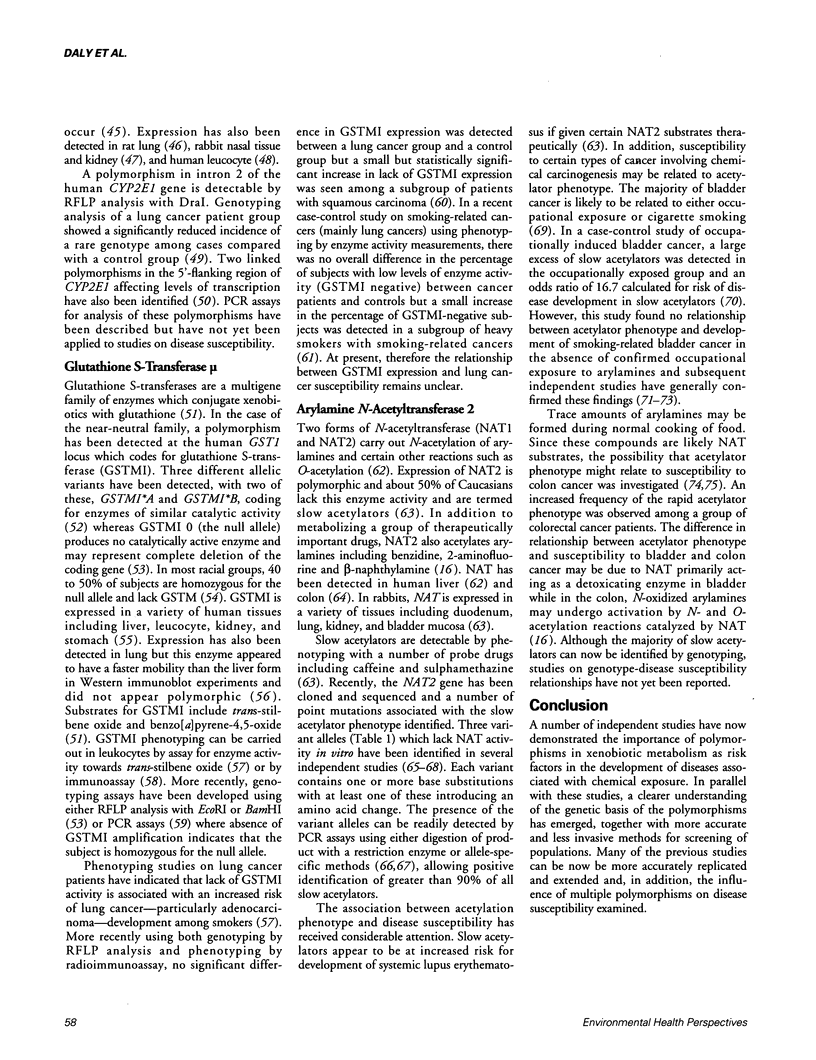

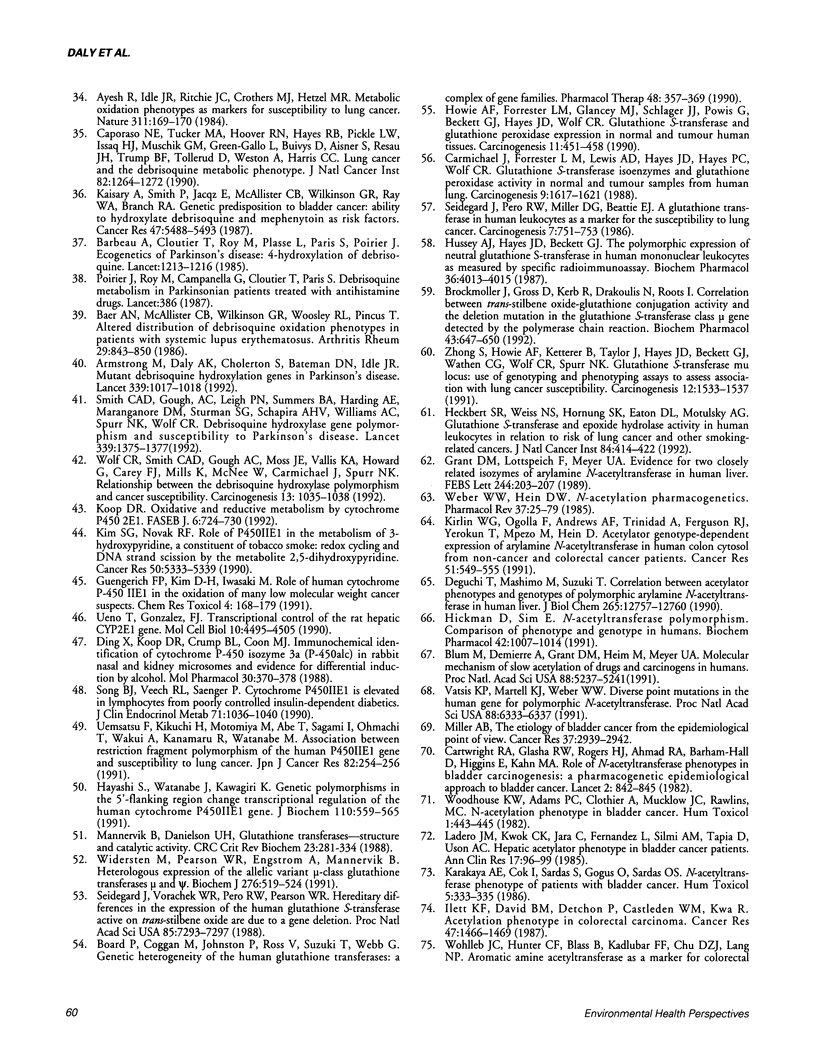
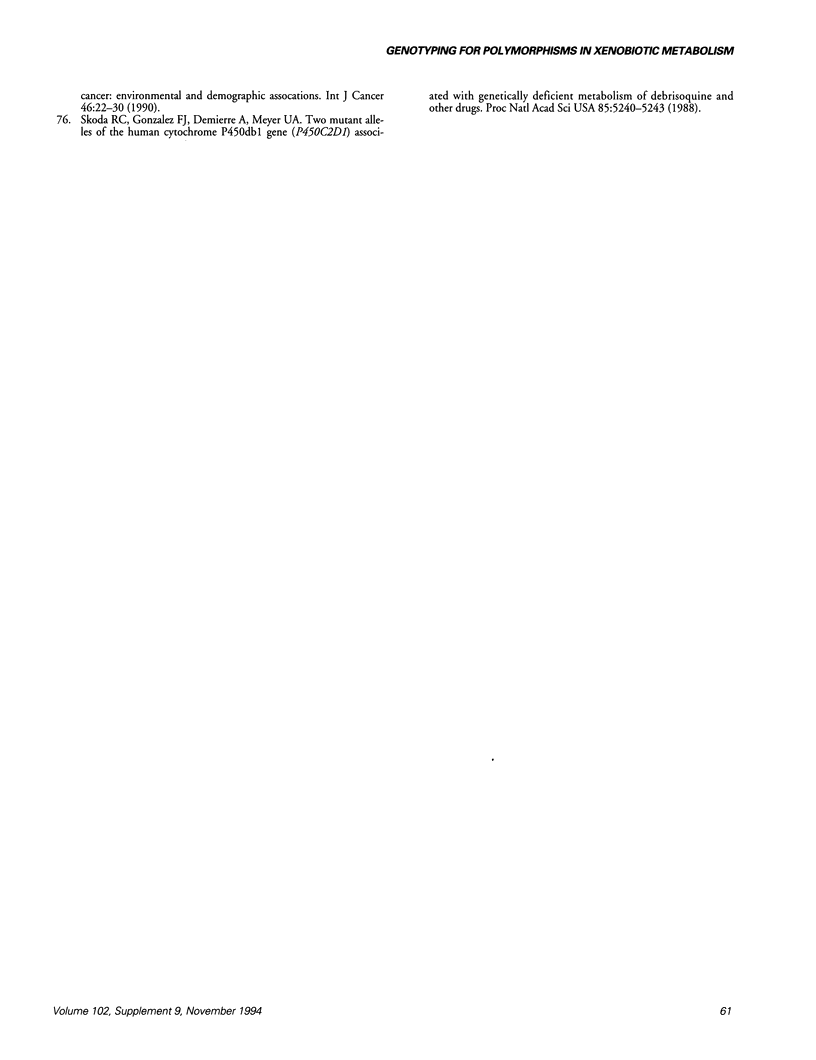
Images in this article
Selected References
These references are in PubMed. This may not be the complete list of references from this article.
- Alván G., Bechtel P., Iselius L., Gundert-Remy U. Hydroxylation polymorphisms of debrisoquine and mephenytoin in European populations. Eur J Clin Pharmacol. 1990;39(6):533–537. doi: 10.1007/BF00316090. [DOI] [PubMed] [Google Scholar]
- Armstrong M., Daly A. K., Cholerton S., Bateman D. N., Idle J. R. Mutant debrisoquine hydroxylation genes in Parkinson's disease. Lancet. 1992 Apr 25;339(8800):1017–1018. doi: 10.1016/0140-6736(92)90537-d. [DOI] [PubMed] [Google Scholar]
- Baer A. N., McAllister C. B., Wilkinson G. R., Woosley R. L., Pincus T. Altered distribution of debrisoquine oxidation phenotypes in patients with systemic lupus erythematosus. Arthritis Rheum. 1986 Jul;29(7):843–850. doi: 10.1002/art.1780290705. [DOI] [PubMed] [Google Scholar]
- Blum M., Demierre A., Grant D. M., Heim M., Meyer U. A. Molecular mechanism of slow acetylation of drugs and carcinogens in humans. Proc Natl Acad Sci U S A. 1991 Jun 15;88(12):5237–5241. doi: 10.1073/pnas.88.12.5237. [DOI] [PMC free article] [PubMed] [Google Scholar]
- Board P., Coggan M., Johnston P., Ross V., Suzuki T., Webb G. Genetic heterogeneity of the human glutathione transferases: a complex of gene families. Pharmacol Ther. 1990;48(3):357–369. doi: 10.1016/0163-7258(90)90054-6. [DOI] [PubMed] [Google Scholar]
- Bock K. W. Metabolic polymorphisms affecting activation of toxic and mutagenic arylamines. Trends Pharmacol Sci. 1992 Jun;13(6):223–226. doi: 10.1016/0165-6147(92)90068-h. [DOI] [PubMed] [Google Scholar]
- Brockmöller J., Gross D., Kerb R., Drakoulis N., Roots I. Correlation between trans-stilbene oxide-glutathione conjugation activity and the deletion mutation in the glutathione S-transferase class mu gene detected by polymerase chain reaction. Biochem Pharmacol. 1992 Feb 4;43(3):647–650. doi: 10.1016/0006-2952(92)90591-6. [DOI] [PubMed] [Google Scholar]
- Broly F., Gaedigk A., Heim M., Eichelbaum M., Morike K., Meyer U. A. Debrisoquine/sparteine hydroxylation genotype and phenotype: analysis of common mutations and alleles of CYP2D6 in a European population. DNA Cell Biol. 1991 Oct;10(8):545–558. doi: 10.1089/dna.1991.10.545. [DOI] [PubMed] [Google Scholar]
- Butler M. A., Iwasaki M., Guengerich F. P., Kadlubar F. F. Human cytochrome P-450PA (P-450IA2), the phenacetin O-deethylase, is primarily responsible for the hepatic 3-demethylation of caffeine and N-oxidation of carcinogenic arylamines. Proc Natl Acad Sci U S A. 1989 Oct;86(20):7696–7700. doi: 10.1073/pnas.86.20.7696. [DOI] [PMC free article] [PubMed] [Google Scholar]
- Butler M. A., Lang N. P., Young J. F., Caporaso N. E., Vineis P., Hayes R. B., Teitel C. H., Massengill J. P., Lawsen M. F., Kadlubar F. F. Determination of CYP1A2 and NAT2 phenotypes in human populations by analysis of caffeine urinary metabolites. Pharmacogenetics. 1992 Jun;2(3):116–127. doi: 10.1097/00008571-199206000-00003. [DOI] [PubMed] [Google Scholar]
- Caporaso N. E., Tucker M. A., Hoover R. N., Hayes R. B., Pickle L. W., Issaq H. J., Muschik G. M., Green-Gallo L., Buivys D., Aisner S. Lung cancer and the debrisoquine metabolic phenotype. J Natl Cancer Inst. 1990 Aug 1;82(15):1264–1272. doi: 10.1093/jnci/82.15.1264. [DOI] [PubMed] [Google Scholar]
- Carmichael J., Forrester L. M., Lewis A. D., Hayes J. D., Hayes P. C., Wolf C. R. Glutathione S-transferase isoenzymes and glutathione peroxidase activity in normal and tumour samples from human lung. Carcinogenesis. 1988 Sep;9(9):1617–1621. doi: 10.1093/carcin/9.9.1617. [DOI] [PubMed] [Google Scholar]
- Cartwright R. A., Glashan R. W., Rogers H. J., Ahmad R. A., Barham-Hall D., Higgins E., Kahn M. A. Role of N-acetyltransferase phenotypes in bladder carcinogenesis: a pharmacogenetic epidemiological approach to bladder cancer. Lancet. 1982 Oct 16;2(8303):842–845. doi: 10.1016/s0140-6736(82)90810-8. [DOI] [PubMed] [Google Scholar]
- Cholerton S., Daly A. K., Idle J. R. The role of individual human cytochromes P450 in drug metabolism and clinical response. Trends Pharmacol Sci. 1992 Dec;13(12):434–439. doi: 10.1016/0165-6147(92)90140-2. [DOI] [PubMed] [Google Scholar]
- Cholerton S., Idle M. E., Vas A., Gonzalez F. J., Idle J. R. Comparison of a novel thin-layer chromatographic-fluorescence detection method with a spectrofluorometric method for the determination of 7-hydroxycoumarin in human urine. J Chromatogr. 1992 Mar 27;575(2):325–330. doi: 10.1016/0378-4347(92)80166-n. [DOI] [PubMed] [Google Scholar]
- Cohen C., Reinhardt B., Parry D. A., Roelants G. E., Hirsch W., Kanwé B. Alpha-helical coiled-coil structures of Trypanosoma brucei variable surface glycoproteins. Nature. 1984 Sep 13;311(5982):169–171. doi: 10.1038/311169a0. [DOI] [PubMed] [Google Scholar]
- Crespi C. L., Penman B. W., Gelboin H. V., Gonzalez F. J. A tobacco smoke-derived nitrosamine, 4-(methylnitrosamino)-1-(3-pyridyl)-1-butanone, is activated by multiple human cytochrome P450s including the polymorphic human cytochrome P4502D6. Carcinogenesis. 1991 Jul;12(7):1197–1201. doi: 10.1093/carcin/12.7.1197. [DOI] [PubMed] [Google Scholar]
- Dahl M. L., Johansson I., Palmertz M. P., Ingelman-Sundberg M., Sjöqvist F. Analysis of the CYP2D6 gene in relation to debrisoquin and desipramine hydroxylation in a Swedish population. Clin Pharmacol Ther. 1992 Jan;51(1):12–17. doi: 10.1038/clpt.1992.2. [DOI] [PubMed] [Google Scholar]
- Daly A. K., Armstrong M., Monkman S. C., Idle M. E., Idle J. R. Genetic and metabolic criteria for the assignment of debrisoquine 4-hydroxylation (cytochrome P4502D6) phenotypes. Pharmacogenetics. 1991 Oct;1(1):33–41. doi: 10.1097/00008571-199110000-00006. [DOI] [PubMed] [Google Scholar]
- Davies R. L., Crespi C. L., Rudo K., Turner T. R., Langenbach R. Development of a human cell line by selection and drug-metabolizing gene transfection with increased capacity to activate promutagens. Carcinogenesis. 1989 May;10(5):885–891. doi: 10.1093/carcin/10.5.885. [DOI] [PubMed] [Google Scholar]
- Deguchi T., Mashimo M., Suzuki T. Correlation between acetylator phenotypes and genotypes of polymorphic arylamine N-acetyltransferase in human liver. J Biol Chem. 1990 Aug 5;265(22):12757–12760. [PubMed] [Google Scholar]
- Ding X. X., Coon M. J. Purification and characterization of two unique forms of cytochrome P-450 from rabbit nasal microsomes. Biochemistry. 1988 Nov 1;27(22):8330–8337. doi: 10.1021/bi00422a007. [DOI] [PubMed] [Google Scholar]
- Ding X. X., Koop D. R., Crump B. L., Coon M. J. Immunochemical identification of cytochrome P-450 isozyme 3a (P-450ALC) in rabbit nasal and kidney microsomes and evidence for differential induction by alcohol. Mol Pharmacol. 1986 Oct;30(4):370–378. [PubMed] [Google Scholar]
- Fonne-Pfister R., Bargetzi M. J., Meyer U. A. MPTP, the neurotoxin inducing Parkinson's disease, is a potent competitive inhibitor of human and rat cytochrome P450 isozymes (P450bufI, P450db1) catalyzing debrisoquine 4-hydroxylation. Biochem Biophys Res Commun. 1987 Nov 13;148(3):1144–1150. doi: 10.1016/s0006-291x(87)80252-8. [DOI] [PubMed] [Google Scholar]
- Gonzalez F. J., Vilbois F., Hardwick J. P., McBride O. W., Nebert D. W., Gelboin H. V., Meyer U. A. Human debrisoquine 4-hydroxylase (P450IID1): cDNA and deduced amino acid sequence and assignment of the CYP2D locus to chromosome 22. Genomics. 1988 Feb;2(2):174–179. doi: 10.1016/0888-7543(88)90100-0. [DOI] [PubMed] [Google Scholar]
- Grant D. M., Lottspeich F., Meyer U. A. Evidence for two closely related isozymes of arylamine N-acetyltransferase in human liver. FEBS Lett. 1989 Feb 13;244(1):203–207. doi: 10.1016/0014-5793(89)81193-7. [DOI] [PubMed] [Google Scholar]
- Guengerich F. P., Kim D. H., Iwasaki M. Role of human cytochrome P-450 IIE1 in the oxidation of many low molecular weight cancer suspects. Chem Res Toxicol. 1991 Mar-Apr;4(2):168–179. doi: 10.1021/tx00020a008. [DOI] [PubMed] [Google Scholar]
- Hayashi S., Watanabe J., Kawajiri K. Genetic polymorphisms in the 5'-flanking region change transcriptional regulation of the human cytochrome P450IIE1 gene. J Biochem. 1991 Oct;110(4):559–565. doi: 10.1093/oxfordjournals.jbchem.a123619. [DOI] [PubMed] [Google Scholar]
- Hayashi S., Watanabe J., Nakachi K., Kawajiri K. Genetic linkage of lung cancer-associated MspI polymorphisms with amino acid replacement in the heme binding region of the human cytochrome P450IA1 gene. J Biochem. 1991 Sep;110(3):407–411. doi: 10.1093/oxfordjournals.jbchem.a123594. [DOI] [PubMed] [Google Scholar]
- Heckbert S. R., Weiss N. S., Hornung S. K., Eaton D. L., Motulsky A. G. Glutathione S-transferase and epoxide hydrolase activity in human leukocytes in relation to risk of lung cancer and other smoking-related cancers. J Natl Cancer Inst. 1992 Mar 18;84(6):414–422. doi: 10.1093/jnci/84.6.414. [DOI] [PubMed] [Google Scholar]
- Hickman D., Sim E. N-acetyltransferase polymorphism. Comparison of phenotype and genotype in humans. Biochem Pharmacol. 1991 Aug 8;42(5):1007–1014. doi: 10.1016/0006-2952(91)90282-a. [DOI] [PubMed] [Google Scholar]
- Howie A. F., Forrester L. M., Glancey M. J., Schlager J. J., Powis G., Beckett G. J., Hayes J. D., Wolf C. R. Glutathione S-transferase and glutathione peroxidase expression in normal and tumour human tissues. Carcinogenesis. 1990 Mar;11(3):451–458. doi: 10.1093/carcin/11.3.451. [DOI] [PubMed] [Google Scholar]
- Hussey A. J., Hayes J. D., Beckett G. J. The polymorphic expression of neutral glutathione S-transferase in human mononuclear leucocytes as measured by specific radioimmunoassay. Biochem Pharmacol. 1987 Nov 15;36(22):4013–4015. doi: 10.1016/0006-2952(87)90472-2. [DOI] [PubMed] [Google Scholar]
- Ilett K. F., David B. M., Detchon P., Castleden W. M., Kwa R. Acetylation phenotype in colorectal carcinoma. Cancer Res. 1987 Mar 1;47(5):1466–1469. [PubMed] [Google Scholar]
- Islam S. A., Wolf C. R., Lennard M. S., Sternberg M. J. A three-dimensional molecular template for substrates of human cytochrome P450 involved in debrisoquine 4-hydroxylation. Carcinogenesis. 1991 Dec;12(12):2211–2219. doi: 10.1093/carcin/12.12.2211. [DOI] [PubMed] [Google Scholar]
- Kaisary A., Smith P., Jaczq E., McAllister C. B., Wilkinson G. R., Ray W. A., Branch R. A. Genetic predisposition to bladder cancer: ability to hydroxylate debrisoquine and mephenytoin as risk factors. Cancer Res. 1987 Oct 15;47(20):5488–5493. [PubMed] [Google Scholar]
- Karakaya A. E., Cok I., Sardas S., Gögüs O., Sardas O. S. N-Acetyltransferase phenotype of patients with bladder cancer. Hum Toxicol. 1986 Sep;5(5):333–335. doi: 10.1177/096032718600500507. [DOI] [PubMed] [Google Scholar]
- Kawajiri K., Nakachi K., Imai K., Yoshii A., Shinoda N., Watanabe J. Identification of genetically high risk individuals to lung cancer by DNA polymorphisms of the cytochrome P450IA1 gene. FEBS Lett. 1990 Apr 9;263(1):131–133. doi: 10.1016/0014-5793(90)80721-t. [DOI] [PubMed] [Google Scholar]
- Kellermann G., Shaw C. R., Luyten-Kellerman M. Aryl hydrocarbon hydroxylase inducibility and bronchogenic carcinoma. N Engl J Med. 1973 Nov 1;289(18):934–937. doi: 10.1056/NEJM197311012891802. [DOI] [PubMed] [Google Scholar]
- Kim S. G., Novak R. F. Role of P450IIE1 in the metabolism of 3-hydroxypyridine, a constituent of tobacco smoke: redox cycling and DNA strand scission by the metabolite 2,5-dihydroxypyridine. Cancer Res. 1990 Sep 1;50(17):5333–5339. [PubMed] [Google Scholar]
- Kirlin W. G., Ogolla F., Andrews A. F., Trinidad A., Ferguson R. J., Yerokun T., Mpezo M., Hein D. W. Acetylator genotype-dependent expression of arylamine N-acetyltransferase in human colon cytosol from non-cancer and colorectal cancer patients. Cancer Res. 1991 Jan 15;51(2):549–555. [PubMed] [Google Scholar]
- Koop D. R. Oxidative and reductive metabolism by cytochrome P450 2E1. FASEB J. 1992 Jan 6;6(2):724–730. doi: 10.1096/fasebj.6.2.1537462. [DOI] [PubMed] [Google Scholar]
- Kouri R. E., McKinney C. E., Slomiany D. J., Snodgrass D. R., Wray N. P., McLemore T. L. Positive correlation between high aryl hydrocarbon hydroxylase activity and primary lung cancer as analyzed in cryopreserved lymphocytes. Cancer Res. 1982 Dec;42(12):5030–5037. [PubMed] [Google Scholar]
- Ladero J. M., Kwok C. K., Jara C., Fernandez L., Silmi A. M., Tapia D., Uson A. C. Hepatic acetylator phenotype in bladder cancer patients. Ann Clin Res. 1985;17(3):96–99. [PubMed] [Google Scholar]
- Matsunaga E., Zanger U. M., Hardwick J. P., Gelboin H. V., Meyer U. A., Gonzalez F. J. The CYP2D gene subfamily: analysis of the molecular basis of the debrisoquine 4-hydroxylase deficiency in DA rats. Biochemistry. 1989 Sep 5;28(18):7349–7355. doi: 10.1021/bi00444a030. [DOI] [PubMed] [Google Scholar]
- McLemore T. L., Adelberg S., Liu M. C., McMahon N. A., Yu S. J., Hubbard W. C., Czerwinski M., Wood T. G., Storeng R., Lubet R. A. Expression of CYP1A1 gene in patients with lung cancer: evidence for cigarette smoke-induced gene expression in normal lung tissue and for altered gene regulation in primary pulmonary carcinomas. J Natl Cancer Inst. 1990 Aug 15;82(16):1333–1339. doi: 10.1093/jnci/82.16.1333. [DOI] [PubMed] [Google Scholar]
- Paigen B., Gurtoo H. L., Minowada J., Houten L., Vincent R., Paigen K., Parker N. B., Ward E., Hayner N. T. Questionable relation of aryl hydrocarbon hydroxylase to lung-cancer risk. N Engl J Med. 1977 Aug 18;297(7):346–350. doi: 10.1056/NEJM197708182970702. [DOI] [PubMed] [Google Scholar]
- Petersen D. D., McKinney C. E., Ikeya K., Smith H. H., Bale A. E., McBride O. W., Nebert D. W. Human CYP1A1 gene: cosegregation of the enzyme inducibility phenotype and an RFLP. Am J Hum Genet. 1991 Apr;48(4):720–725. [PMC free article] [PubMed] [Google Scholar]
- Prasad R., Prasad N., Harrell J. E., Thornby J., Liem J. H., Hudgins P. T., Tsuang J. Aryl hydrocarbon hydroxylase inducibility and lymphoblast formation in lung cancer patients. Int J Cancer. 1979 Mar 15;23(3):316–320. doi: 10.1002/ijc.2910230308. [DOI] [PubMed] [Google Scholar]
- Seidegård J., Pero R. W., Miller D. G., Beattie E. J. A glutathione transferase in human leukocytes as a marker for the susceptibility to lung cancer. Carcinogenesis. 1986 May;7(5):751–753. doi: 10.1093/carcin/7.5.751. [DOI] [PubMed] [Google Scholar]
- Seidegård J., Vorachek W. R., Pero R. W., Pearson W. R. Hereditary differences in the expression of the human glutathione transferase active on trans-stilbene oxide are due to a gene deletion. Proc Natl Acad Sci U S A. 1988 Oct;85(19):7293–7297. doi: 10.1073/pnas.85.19.7293. [DOI] [PMC free article] [PubMed] [Google Scholar]
- Shimada T., Guengerich F. P. Activation of amino-alpha-carboline, 2-amino-1-methyl-6-phenylimidazo[4,5-b]pyridine and a copper phthalocyanine cellulose extract of cigarette smoke condensate by cytochrome P-450 enzymes in rat and human liver microsomes. Cancer Res. 1991 Oct 1;51(19):5284–5291. [PubMed] [Google Scholar]
- Shimada T., Yun C. H., Yamazaki H., Gautier J. C., Beaune P. H., Guengerich F. P. Characterization of human lung microsomal cytochrome P-450 1A1 and its role in the oxidation of chemical carcinogens. Mol Pharmacol. 1992 May;41(5):856–864. [PubMed] [Google Scholar]
- Skoda R. C., Gonzalez F. J., Demierre A., Meyer U. A. Two mutant alleles of the human cytochrome P-450db1 gene (P450C2D1) associated with genetically deficient metabolism of debrisoquine and other drugs. Proc Natl Acad Sci U S A. 1988 Jul;85(14):5240–5243. doi: 10.1073/pnas.85.14.5240. [DOI] [PMC free article] [PubMed] [Google Scholar]
- Smith C. A., Gough A. C., Leigh P. N., Summers B. A., Harding A. E., Maraganore D. M., Sturman S. G., Schapira A. H., Williams A. C., Maranganore D. M. Debrisoquine hydroxylase gene polymorphism and susceptibility to Parkinson's disease. Lancet. 1992 Jun 6;339(8806):1375–1377. doi: 10.1016/0140-6736(92)91196-f. [DOI] [PubMed] [Google Scholar]
- Song B. J., Veech R. L., Saenger P. Cytochrome P450IIE1 is elevated in lymphocytes from poorly controlled insulin-dependent diabetics. J Clin Endocrinol Metab. 1990 Oct;71(4):1036–1040. doi: 10.1210/jcem-71-4-1036. [DOI] [PubMed] [Google Scholar]
- Suzuki T., Fujita S., Narimatsu S., Masubuchi Y., Tachibana M., Ohta S., Hirobe M. Cytochrome P450 isozymes catalyzing 4-hydroxylation of parkinsonism-related compound 1,2,3,4-tetrahydroisoquinoline in rat liver microsomes. FASEB J. 1992 Jan 6;6(2):771–776. doi: 10.1096/fasebj.6.2.1537468. [DOI] [PubMed] [Google Scholar]
- Tefre T., Ryberg D., Haugen A., Nebert D. W., Skaug V., Brøgger A., Børresen A. L. Human CYP1A1 (cytochrome P(1)450) gene: lack of association between the Msp I restriction fragment length polymorphism and incidence of lung cancer in a Norwegian population. Pharmacogenetics. 1991 Oct;1(1):20–25. doi: 10.1097/00008571-199110000-00004. [DOI] [PubMed] [Google Scholar]
- Tyndale R. F., Sunahara R., Inaba T., Kalow W., Gonzalez F. J., Niznik H. B. Neuronal cytochrome P450IID1 (debrisoquine/sparteine-type): potent inhibition of activity by (-)-cocaine and nucleotide sequence identity to human hepatic P450 gene CYP2D6. Mol Pharmacol. 1991 Jul;40(1):63–68. [PubMed] [Google Scholar]
- Uematsu F., Kikuchi H., Motomiya M., Abe T., Sagami I., Ohmachi T., Wakui A., Kanamaru R., Watanabe M. Association between restriction fragment length polymorphism of the human cytochrome P450IIE1 gene and susceptibility to lung cancer. Jpn J Cancer Res. 1991 Mar;82(3):254–256. doi: 10.1111/j.1349-7006.1991.tb01838.x. [DOI] [PMC free article] [PubMed] [Google Scholar]
- Ueno T., Gonzalez F. J. Transcriptional control of the rat hepatic CYP2E1 gene. Mol Cell Biol. 1990 Sep;10(9):4495–4505. doi: 10.1128/mcb.10.9.4495. [DOI] [PMC free article] [PubMed] [Google Scholar]
- Vatsis K. P., Martell K. J., Weber W. W. Diverse point mutations in the human gene for polymorphic N-acetyltransferase. Proc Natl Acad Sci U S A. 1991 Jul 15;88(14):6333–6337. doi: 10.1073/pnas.88.14.6333. [DOI] [PMC free article] [PubMed] [Google Scholar]
- Wall K. L., Gao W. S., te Koppele J. M., Kwei G. Y., Kauffman F. C., Thurman R. G. The liver plays a central role in the mechanism of chemical carcinogenesis due to polycyclic aromatic hydrocarbons. Carcinogenesis. 1991 May;12(5):783–786. doi: 10.1093/carcin/12.5.783. [DOI] [PubMed] [Google Scholar]
- Ward E., Paigen B., Steenland K., Vincent R., Minowada J., Gurtoo H. L., Sartori P., Havens M. B. Aryl hydrocarbon hydroxylase in persons with lung or laryngeal cancer. Int J Cancer. 1978 Oct 15;22(4):384–389. doi: 10.1002/ijc.2910220404. [DOI] [PubMed] [Google Scholar]
- Weber W. W., Hein D. W. N-acetylation pharmacogenetics. Pharmacol Rev. 1985 Mar;37(1):25–79. [PubMed] [Google Scholar]
- Widersten M., Pearson W. R., Engström A., Mannervik B. Heterologous expression of the allelic variant mu-class glutathione transferases mu and psi. Biochem J. 1991 Jun 1;276(Pt 2):519–524. doi: 10.1042/bj2760519. [DOI] [PMC free article] [PubMed] [Google Scholar]
- Wohlleb J. C., Hunter C. F., Blass B., Kadlubar F. F., Chu D. Z., Lang N. P. Aromatic amine acetyltransferase as a marker for colorectal cancer: environmental and demographic associations. Int J Cancer. 1990 Jul 15;46(1):22–30. doi: 10.1002/ijc.2910460107. [DOI] [PubMed] [Google Scholar]
- Wolf C. R., Smith C. A., Gough A. C., Moss J. E., Vallis K. A., Howard G., Carey F. J., Mills K., McNee W., Carmichael J. Relationship between the debrisoquine hydroxylase polymorphism and cancer susceptibility. Carcinogenesis. 1992 Jun;13(6):1035–1038. doi: 10.1093/carcin/13.6.1035. [DOI] [PubMed] [Google Scholar]
- Woodhouse K. W., Adams P. C., Clothier A., Mucklow J. C., Rawlins M. D. N-acetylation phenotype in bladder cancer. Hum Toxicol. 1982 Oct;1(4):443–445. doi: 10.1177/096032718200100411. [DOI] [PubMed] [Google Scholar]
- Yamano S., Tatsuno J., Gonzalez F. J. The CYP2A3 gene product catalyzes coumarin 7-hydroxylation in human liver microsomes. Biochemistry. 1990 Feb 6;29(5):1322–1329. doi: 10.1021/bi00457a031. [DOI] [PubMed] [Google Scholar]
- Yun C. H., Shimada T., Guengerich F. P. Purification and characterization of human liver microsomal cytochrome P-450 2A6. Mol Pharmacol. 1991 Nov;40(5):679–685. [PubMed] [Google Scholar]
- Zhong S., Howie A. F., Ketterer B., Taylor J., Hayes J. D., Beckett G. J., Wathen C. G., Wolf C. R., Spurr N. K. Glutathione S-transferase mu locus: use of genotyping and phenotyping assays to assess association with lung cancer susceptibility. Carcinogenesis. 1991 Sep;12(9):1533–1537. doi: 10.1093/carcin/12.9.1533. [DOI] [PubMed] [Google Scholar]



